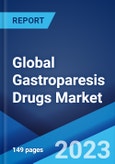The global gastroparesis drugs market size reached US$ 6.2 Billion in 2022. Looking forward, the market is expected to reach US$ 8.2 Billion by 2028, exhibiting a growth rate (CAGR) of 4.77% during 2022-2028.
Gastroparesis, also known as stomach paralysis, is a medical condition that affects the normal and spontaneous movement of the muscles in the stomach. It interferes with the digestion process and causes nausea, vomiting, abdominal pain, and problems with maintaining blood sugar levels and nutrition absorption. At present, it is treated under the guidance of doctors using drugs, such as domperidone, metoclopramide, erythromycin, diphenhydramine, ondansetron, and prochlorperazine.
2. What is the expected growth rate of the global gastroparesis drugs market during 2023-2028?
3. What has been the impact of COVID-19 on the global gastroparesis drugs market?
4. What are the key factors driving the global gastroparesis drugs market?
5. What is the breakup of the global gastroparesis drugs market based on the disease type?
6. What is the breakup of the global gastroparesis drugs market based on the drug class?
7. What is the breakup of the global gastroparesis drugs market based on the distribution channel?
8. What are the key regions in the global gastroparesis drugs market?
9. Who are the key players/companies in the global gastroparesis drugs market?
Gastroparesis, also known as stomach paralysis, is a medical condition that affects the normal and spontaneous movement of the muscles in the stomach. It interferes with the digestion process and causes nausea, vomiting, abdominal pain, and problems with maintaining blood sugar levels and nutrition absorption. At present, it is treated under the guidance of doctors using drugs, such as domperidone, metoclopramide, erythromycin, diphenhydramine, ondansetron, and prochlorperazine.
Gastroparesis Drugs Market Trends
Due to rapid urbanization, sedentary lifestyles and the growing number of individuals who drink and smoke regularly, there is a significant rise in the prevalence of diabetes across the globe. This, in confluence with the increasing geriatric population, which is relatively more susceptible to developing gastroparesis, represents one of the key factors bolstering the growth of the market. In addition, gastroparesis drugs aid in enhancing gastrointestinal motility by improving the frequency of contraction. As a result, they are extensively being utilized for treating idiopathic gastroparesis, which causes severe vomiting, nausea, and upper abdominal pain. This, along with a considerable rise in the number of individuals developing gastroparesis after the vague nerve and its branches are damaged via surgical operations, are also contributing to market growth. Furthermore, leading manufacturers are continuously funding research and development (R&D) projects to introduce new approaches to the existing drug therapy. They are also developing advanced and effective drugs that can be administered via the nasal cavity for individuals who are experiencing symptoms of gastroparesis, which is creating a favorable market outlook. Other major factors, including the improving healthcare infrastructure and the escalating demand for user-friendly drugs, are anticipated to impel the growth of the market.Key Market Segmentation
This research provides an analysis of the key trends in each sub-segment of the global gastroparesis drugs market report, along with forecasts at the global, regional and country level from 2023-2028. The report has categorized the market based on disease type, drug class and distribution channel.Breakup by Disease Type:
- Diabetic Gastroparesis
- Idiopathic Gastroparesis
- Post-surgical Gastroparesis
Breakup by Drug Class:
- Prokinetic Agents
- Antiemetic Agents
- Botulinum Toxin Injections
Breakup by Distribution Channel:
- Hospitals and Clinics
- Pharmacies
- Online Stores
Breakup by Region:
- North America
- United States
- Canada
- Asia-Pacific
- China
- Japan
- India
- South Korea
- Australia
- Indonesia
- Europe
- Germany
- France
- United Kingdom
- Italy
- Spain
- Russia
- Latin America
- Brazil
- Mexico
- Middle East and Africa
Competitive Landscape
The competitive landscape of the industry has also been examined along with the profiles of the key players being Abbott Laboratories, Abbvie Inc., AstraZeneca Plc, Bausch Health Companies Inc., Becton Dickinson and Company, Boston Scientific Corporation, Evoke Pharma, Medtronic plc, Neurogastrx Inc., Sanofi S.A., Takeda Pharmaceutical Company Limited and Theravance Biopharma.Key Questions Answered in This Report
1. What was the size of the global gastroparesis drugs market in 2022?2. What is the expected growth rate of the global gastroparesis drugs market during 2023-2028?
3. What has been the impact of COVID-19 on the global gastroparesis drugs market?
4. What are the key factors driving the global gastroparesis drugs market?
5. What is the breakup of the global gastroparesis drugs market based on the disease type?
6. What is the breakup of the global gastroparesis drugs market based on the drug class?
7. What is the breakup of the global gastroparesis drugs market based on the distribution channel?
8. What are the key regions in the global gastroparesis drugs market?
9. Who are the key players/companies in the global gastroparesis drugs market?
Table of Contents
1 Preface3 Executive Summary11 Value Chain Analysis13 Price Analysis
2 Scope and Methodology
4 Introduction
5 Global Gastroparesis Drugs Market
6 Market Breakup by Disease Type
7 Market Breakup by Drug Class
8 Market Breakup by Distribution Channel
9 Market Breakup by Region
10 SWOT Analysis
12 Porters Five Forces Analysis
14 Competitive Landscape
Companies Mentioned
- Abbott Laboratories
- Abbvie Inc.
- AstraZeneca Plc
- Bausch Health Companies Inc.
- Becton Dickinson and Company
- Boston Scientific Corporation
- Evoke Pharma
- Medtronic plc
- Neurogastrx Inc.
- Sanofi S.A.
- Takeda Pharmaceutical Company Limited
- Theravance Biopharma
Methodology

LOADING...
Table Information
| Report Attribute | Details |
|---|---|
| No. of Pages | 149 |
| Published | November 2023 |
| Forecast Period | 2022 - 2028 |
| Estimated Market Value ( USD | $ 6.2 Billion |
| Forecasted Market Value ( USD | $ 8.2 Billion |
| Compound Annual Growth Rate | 4.8% |
| Regions Covered | Global |
| No. of Companies Mentioned | 12 |









